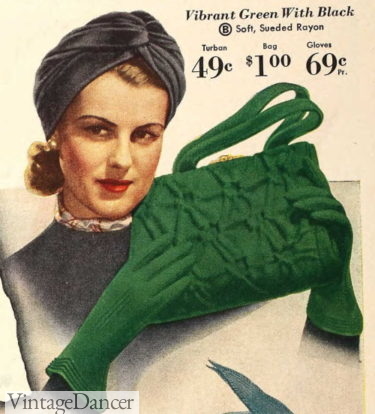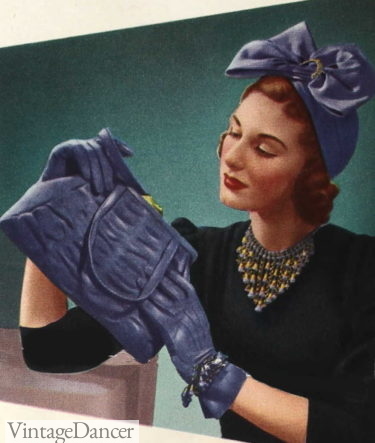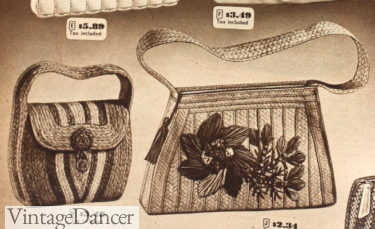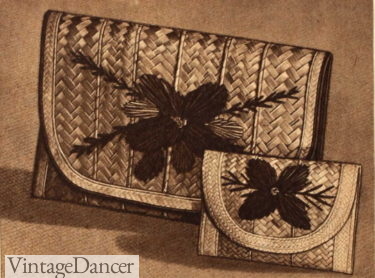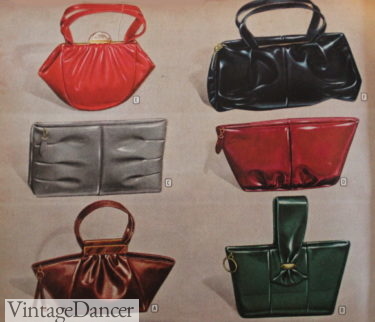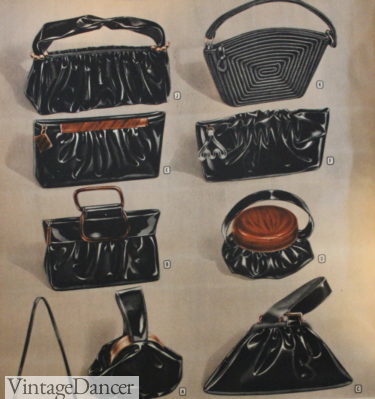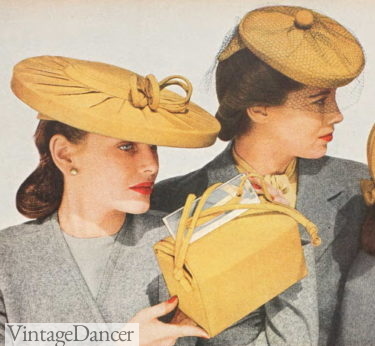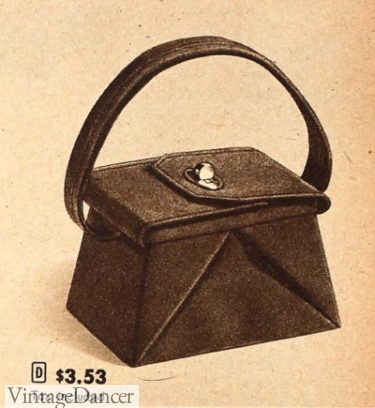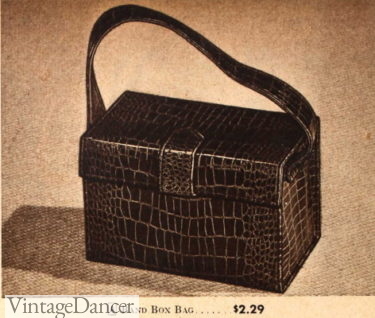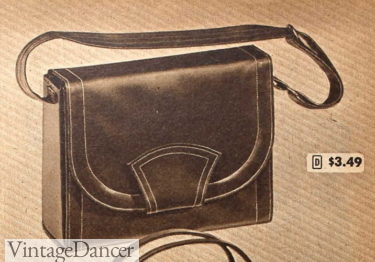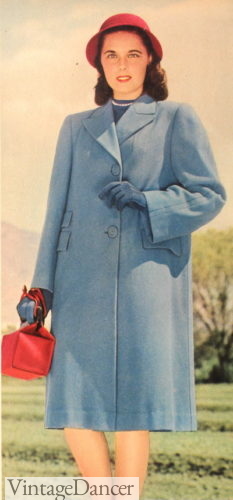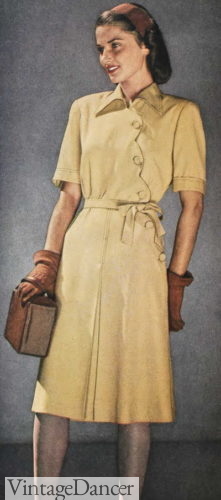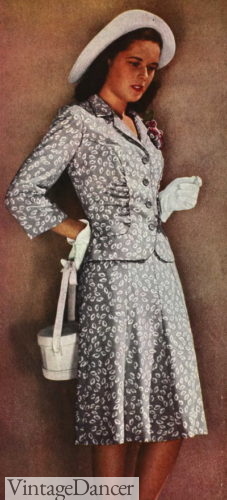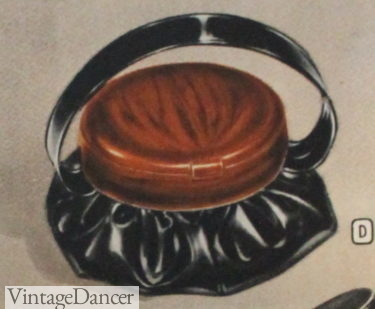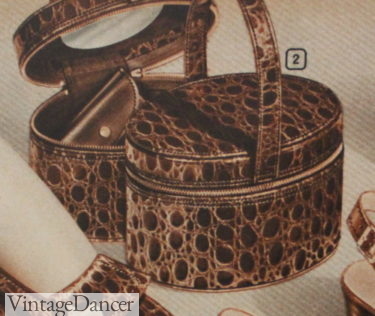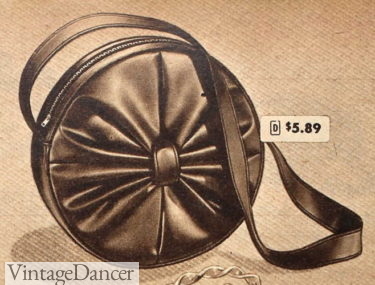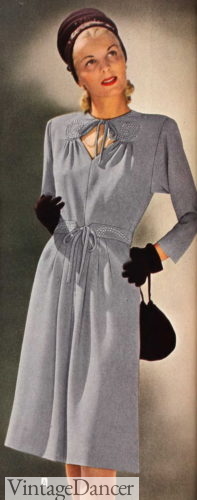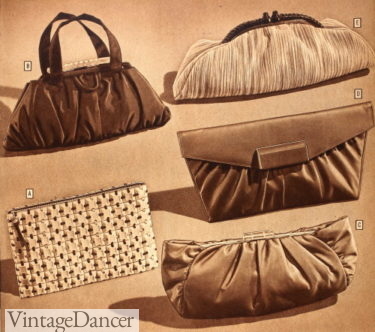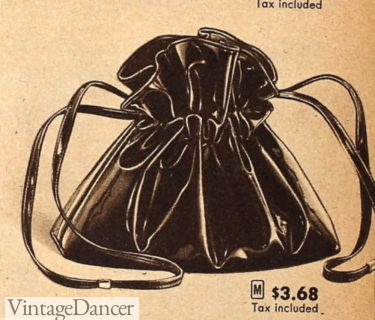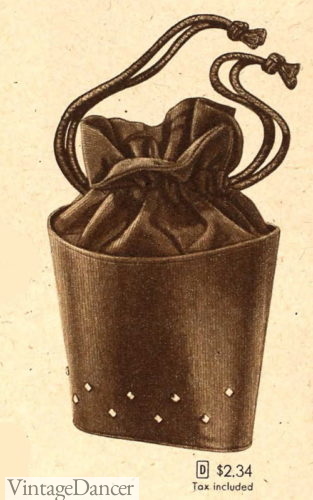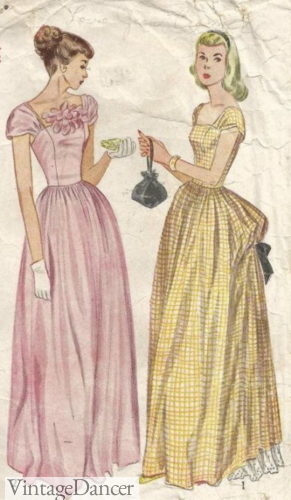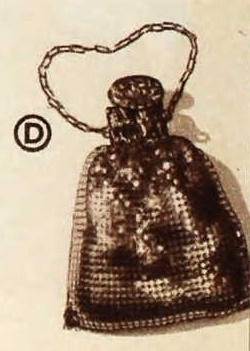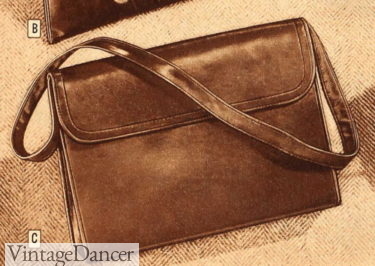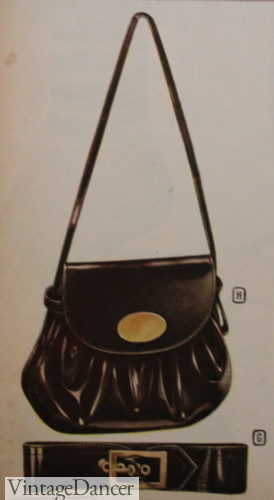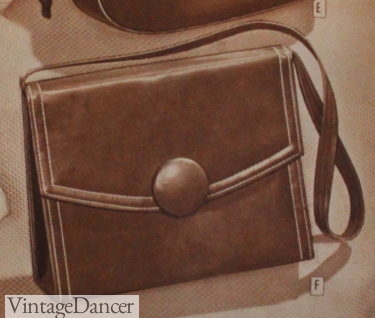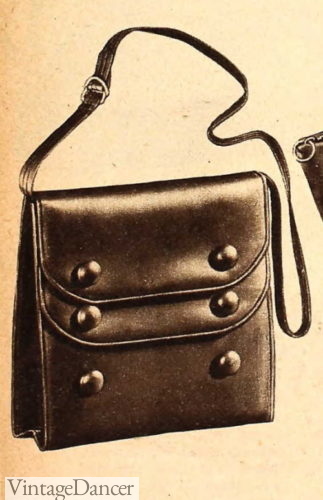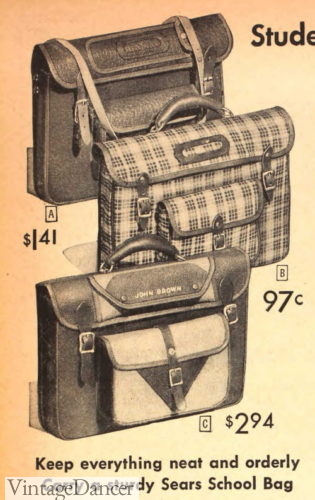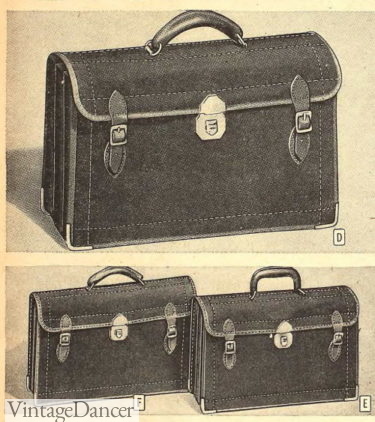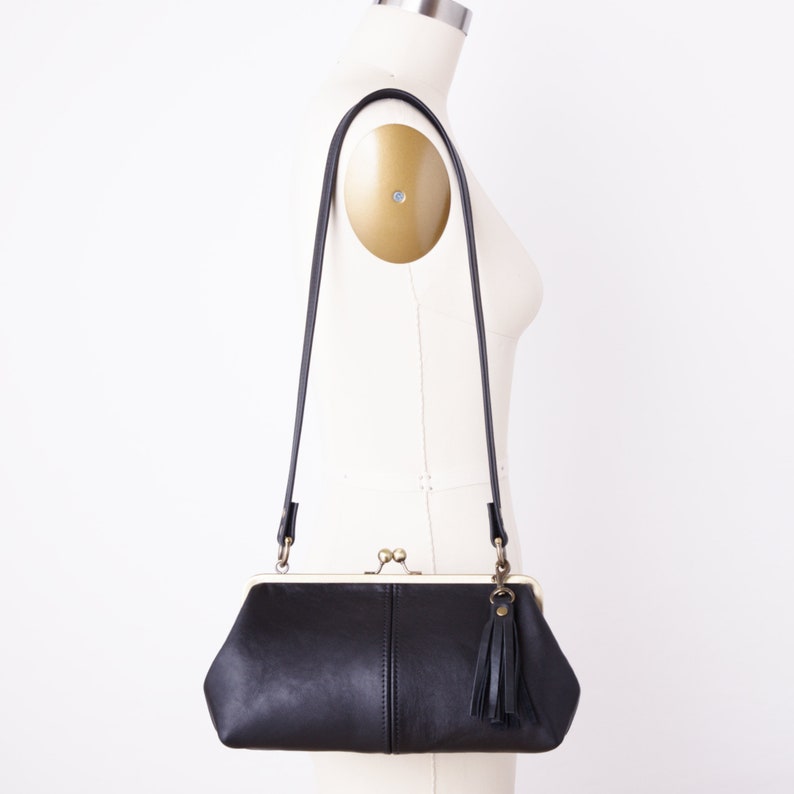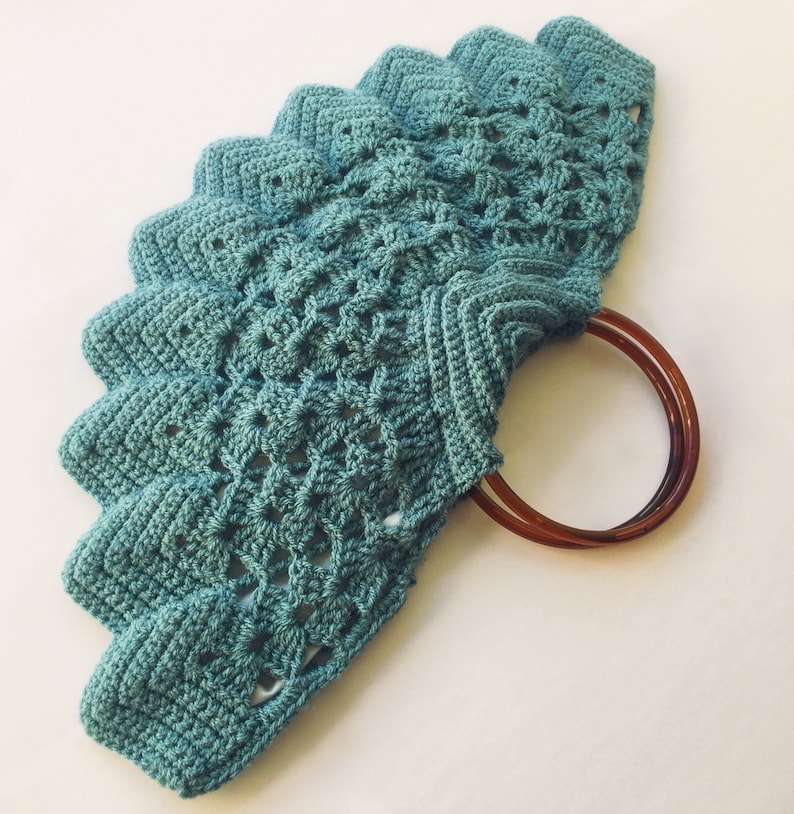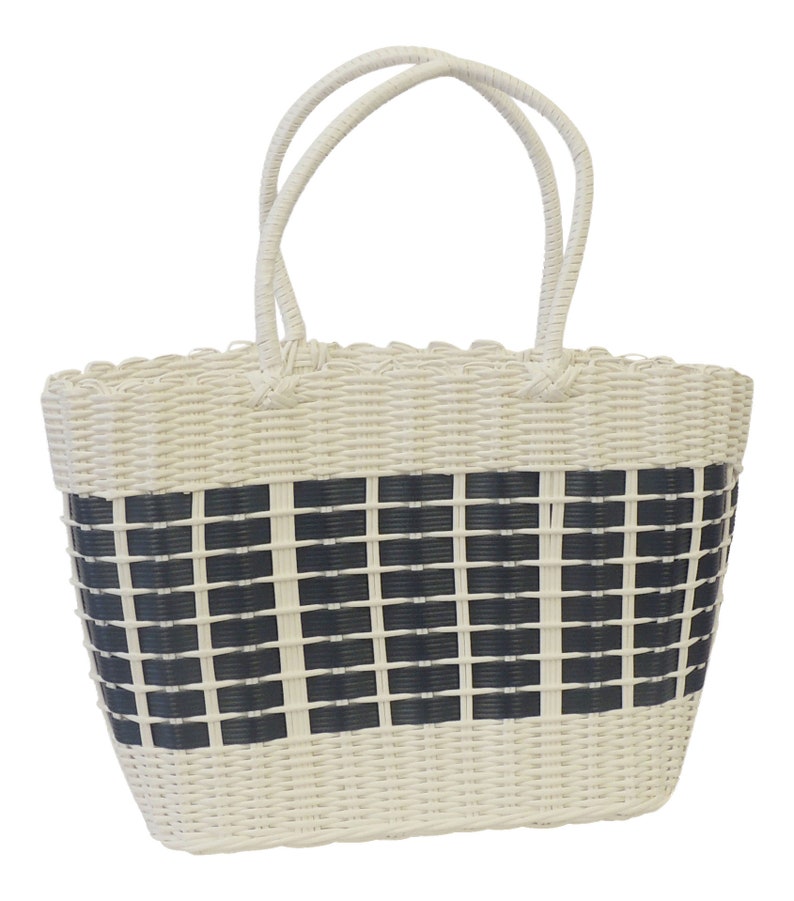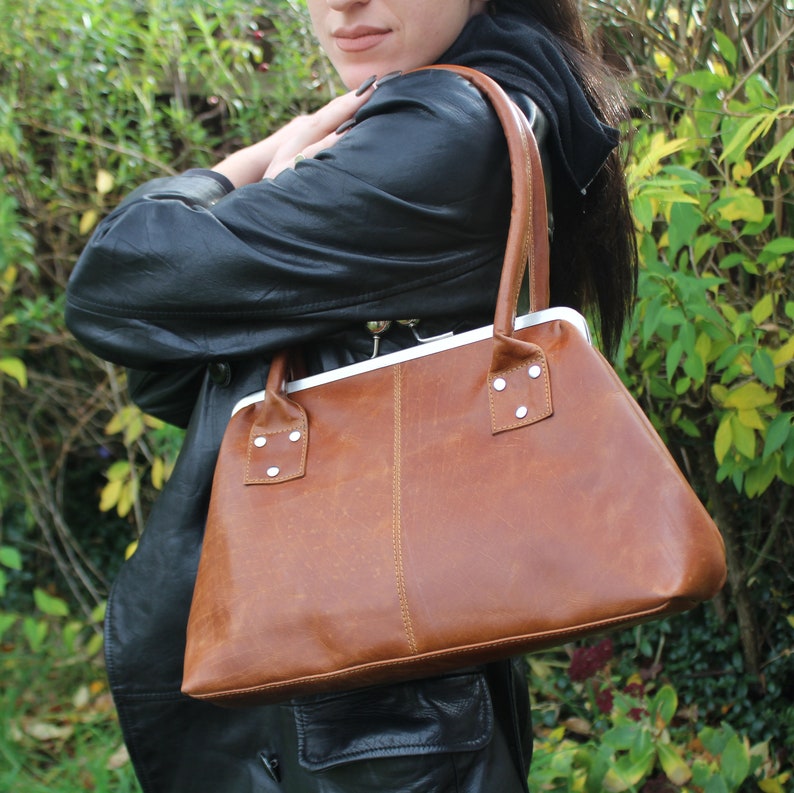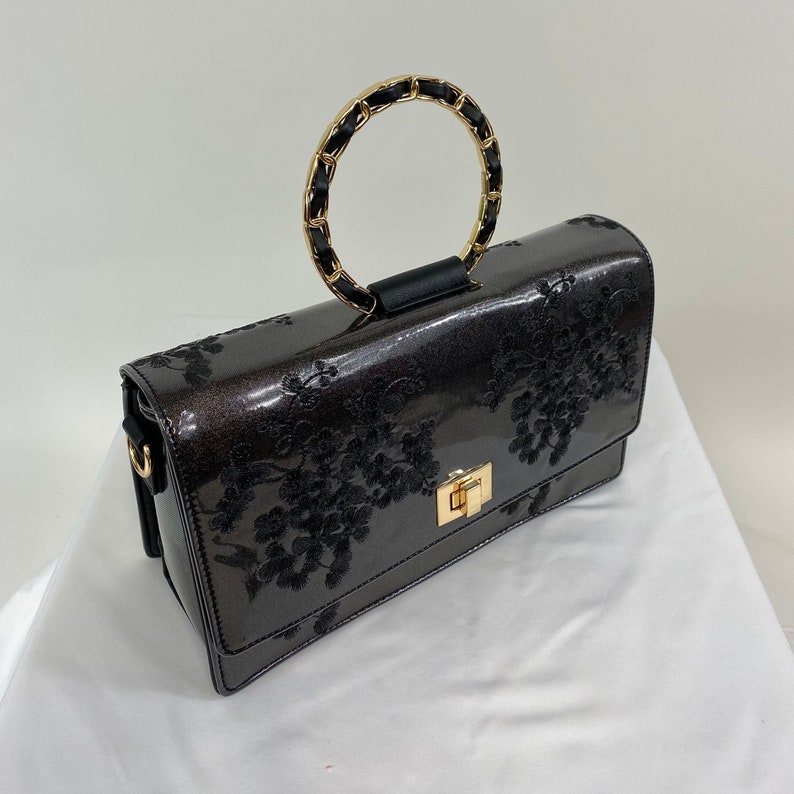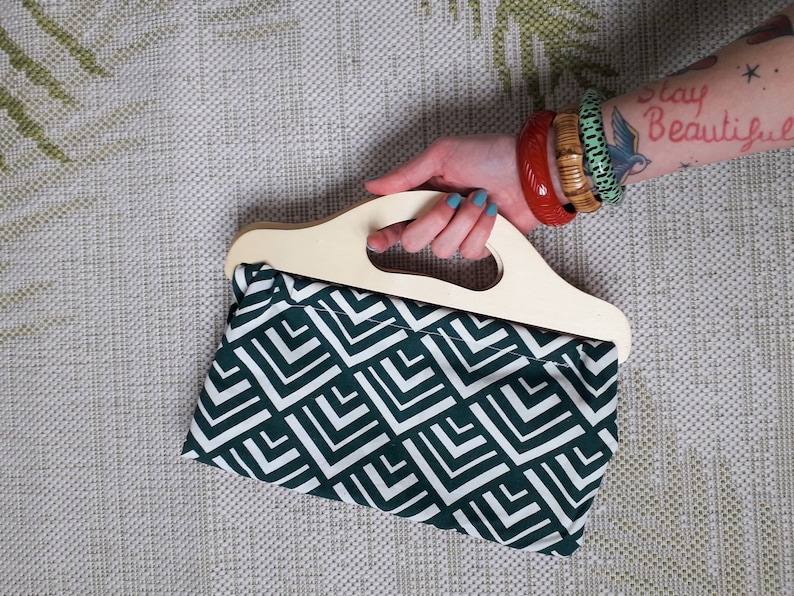While the 1930s provided scope for exploration of the aesthetics of bags and purses, the 1940s focused on functionality and practicality.
The 1940s was the decade of make-do-and-mend, innovation, and functionality. This approach has resulted in perhaps the first truly practical bags for women, of which many styles are still worn today.
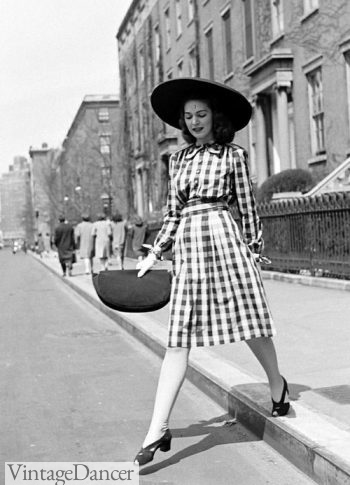
The size of her envelope purse matches that of her large sun hat
The previous decade witnessed the birth of the handbag or purse as a fashion accessory within its own right. However, in the 1940s bags became essential daily items that served a duty and function on a much larger scale.
Small handheld clutches were too impractical for a woman during war time. Large 1940s handbags and shoulder bags held more and were easier to carry.
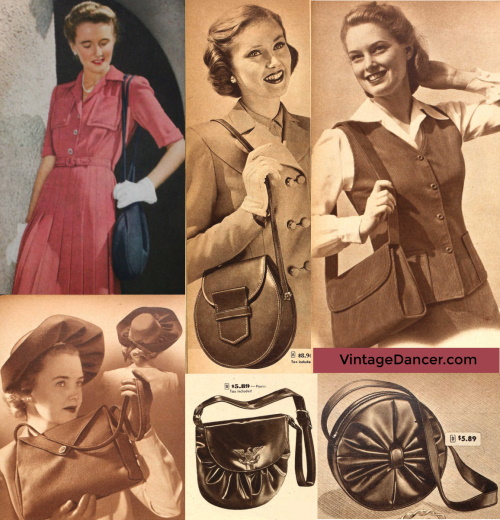
1940s shoulder strap purses
The plain and practical leather bag of the early 1940s grew into the vibrant synthetic statement bags of the New Look in the late 1940s. It was a unique time in purse history.
1940s Handbags And Purses – From Fashion Accessory To Necessity
Prior to WWII, women only needed to carry a few essential items about their person on a daily basis. Makeup, a coin purse, perhaps a cigarette case if so inclined. However, this all changed during WWII. Cosmetics grew larger in the 1940s and women carried more of them. A handkerchief, gloves, perfume, coin purse, key purse, and mirror were some of the items carried at all times.
- 1940 embossed green handbag with gloves
- 1940 ruched purse with matching accessories
Inspired by the style design from wartime uniform messenger bags, deep purses with long handles became popular. It was desirable and practical to have a bag that could be slung over a shoulder and out of the way. They were often monogramed.
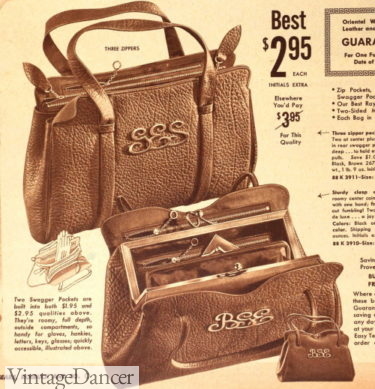
1941 handle zipper or frame bags
The bags were about 12 inches wide and mostly flat like the clutch bags of the 1930s. Leather in black or brown was preferred. These large clutch bags were renamed envelope bags that could open up with a metal frame but increasingly used zippers when metal was in short supply.
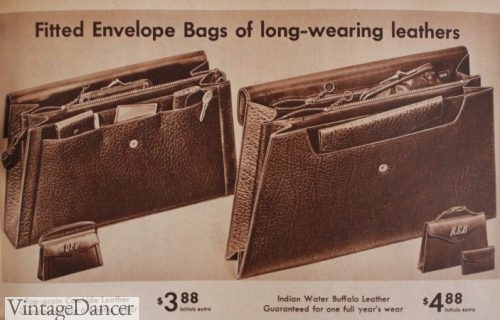
1942 flat envelope bag with many compartments
Besides the rectangular envelope bag, there was the more elegant shell or scallop shaped bag. This bag had a wide round bottom that gathered to a smaller top with or without handles. Gathered ruching pleats echoed the shell texture and added to the elegance of the design.
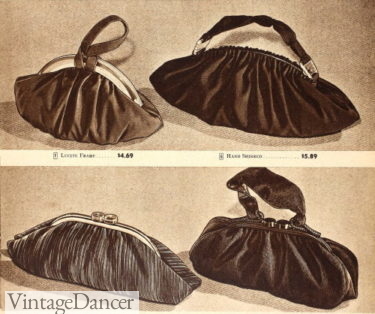
1945 scallop ruched bags
A similar early 1940s bag was the winged bag with upward protruding tips on a long gathered base.
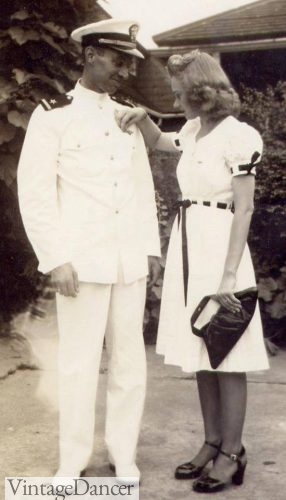
A lovely ruched bag
The envelope bag and shell bag were the cornerstone styles of most large 1940s handbags. The wrist bag was a smaller design in the early ’40s that featured a wide single strap worn around the wrist. These little bags did not stay small for long. As the years progressed, they grew to be larger, moving the strap from the wrist to the forearm. This marked a change from practicality back into pure fashion that inspired most of the 1950s designs.
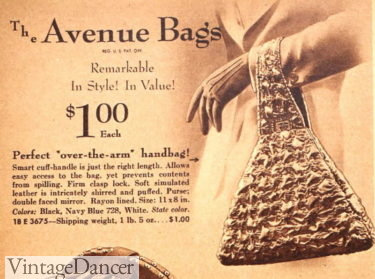
1940 arm cuff purse with shirred and puffed texture
1940s Purses Made With New Materials
As materials such as metal and leather were reserved for the war effort, and L-85 restrictions put in place, alternatives had to be sought for fashionable, functional bags. As a result, unusual materials and fabrics became popular. A make do and mend approach was adopted – not only across clothing, but also accessories.
Various animal and reptile skins such as buffalo, pigskin, goatskin, alligator, and snakeskin became a popular choice in handbag production (as well as shoes). These continued well after the war ended as it took some time for supplies to re-stock back to pre-war levels.
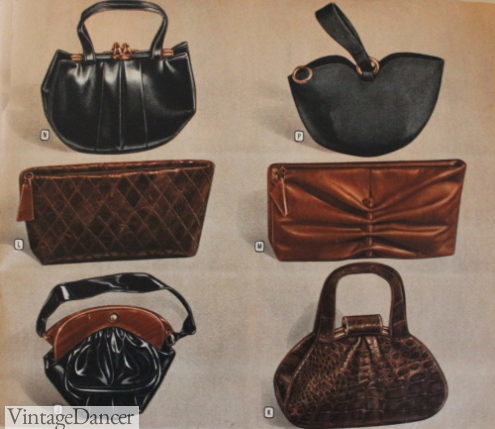
1947 leather, patent or reptile skin handbags
Crochet Bags
Women could make their own purses from small pieces of fabrics. The simplest style to make was the drawstring pouch design, which also used only a fraction of material. Knitting and crochet were popular pastimes, and many bags of this era were actually crocheted. Beautiful crochet designs could be made using minimal sources – handles, lining, yarn, and a fastening.
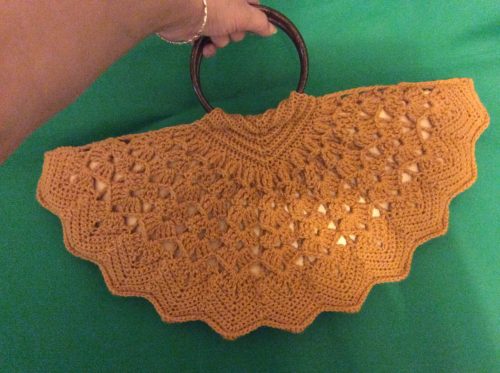
This reproduction crochet bag by Original Crochet by Q on Etsy is a wonderful example of 1940s ingenuity.
Fabric Bags
As items of clothing were re-purposed, scraps of fabric could be made into patchwork material. This would create an entirely new fabric in its own right to be used to make bags, purses and some clothing. Manufactures followed the homemade trend and began selling cheap fabric bags made of cotton, felt or wool blends such as these:
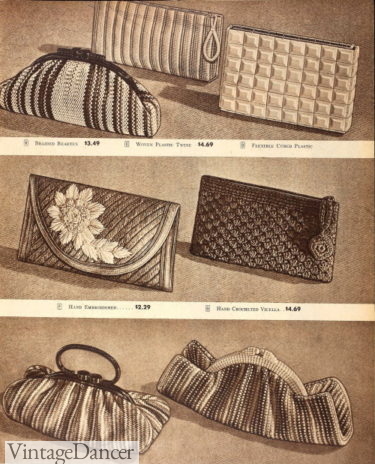
1945 plastic, straw and fabric bags
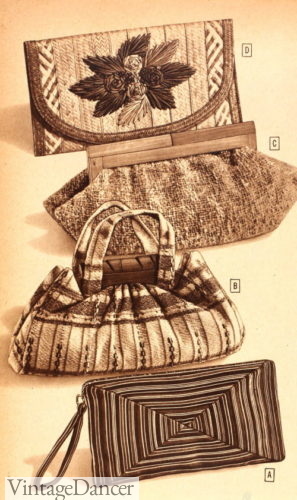
1943 straw, wool with wood frame, cotton cloth, and corded purses
Corded rayon was perhaps the most versatile of the fabric bags. It was durable for daywear and elegant enough for evenings.
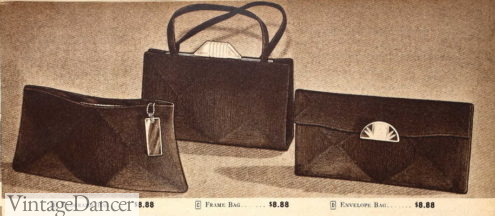
1945 corded purses with Lucite pulls
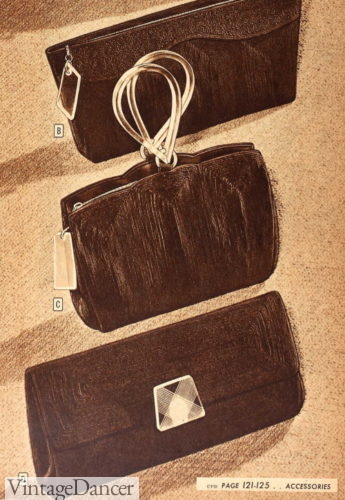
1944 corded rayon purses with Lucite pulls or clasp
Straw clutch bags were also very trendy in the summer. They featured embroidered sunflowers, roses and nautical themes.
- 1947 straw handle purses
- 1945 straw clutch and wallet purse
Plastic
In place of metal handles and fastenings, Bakelite and lucite plastics were often used. These made not only a functional substitute, but also an attractive (and today – highly collectible) design. Besides Lucite clasps, hardwood was stained with a high gloss finish. This mimicked the plastic look.
A craze for woven plastic purses swept the nation in the late ’40s. Popular styles were rectangular clutches and fan shapes either with straps or in clutch form. The bags were made from plastic that was woven to look like a crocheted material (the fan shaped bags weren’t gathered for the plastic versions). They could come in any number of bright colors and sizes.
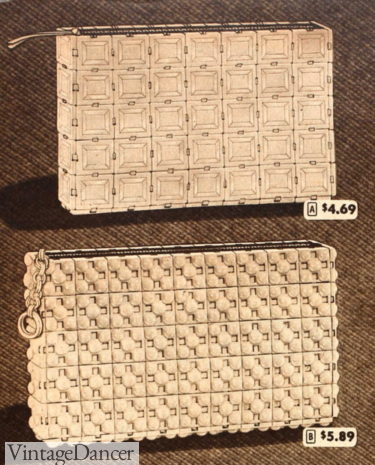
1946 woven plastic bags
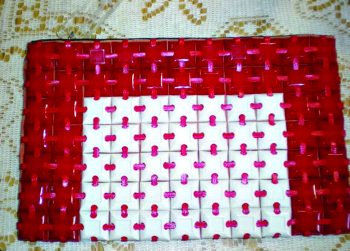
Woven plastic purse (sold out) on etsy
Other common bag styles made of plastic or synthetic fabrics were made to look like patent leather, textured reptile skins and suede. Plastic made it possible for bags to come in lighter and brighter colors such as white for summer.
Red, green and yellow shiny patent bags were especially popular in the late 1940s. They also could be created in new, stiff shapes such as the circular vanity bag or square box bag.
- 1947 patent leather colorful handbags
- 1947 patent black purses
Unusual Shapes
The box bag was not unheard of in the fashionable 1930s, but it went mainstream in the mid 1940s. Some were squared or rectangle boxes with short handles and folded tops like a Chinese Take out container.
Box purses were often made with multiple compartments and matching makeup and beauty compacts. These became known as Vanity cases.
- 1945 yellow bar box purse
- 1948 Asian style box purse
- 1945 alligator box Vanity purse
- 1946 box purse with shoulder strap
The bar box was one unique shape. The two thin handle inserted though a clear plastic bar which was then held with the fingers. It was more comfortable to carry than fingers and palm grasping a square top box.
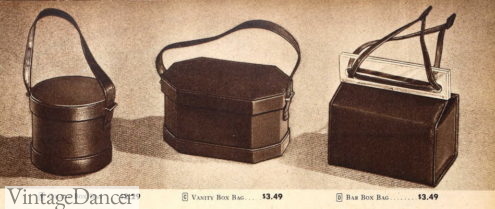
1945 collar box, vanity box, bar box purses
- 1945 red bar box
- 1945 box case purse
- 1945 cylinder box purse
Square boxes were not the only “box purses.” Round, oval, and circle top pouches were made into vanity purses and shoulder bags. Others were cylinders named “collar boxes” or the “flower pot” with a tapered round base and a drawstring top.
- 1947 vanity punch back with faux wood top
- 1948 crocodile vanity case purse
- 1946 tambourine shoulder strap purse
These unusual shape box purses would continue on in the 1950s adding more colors and new textures.
1940s Evening Bags & Purses
1940s evening bags closely resembled these daytime bags, except they were smaller and made of different materials. Small evening purses were made of satin, silky rayon, or rayon velvet. Sparkling brocade and black felt with a glint clasp were also common evening purse designs.
- 1946 black pouch bag with drawstring
- 1943 dressy handbags
The strap would be short and colors would be more varied for evening bags, matching or coordinating with the dress and shoes. The no-strap clutch bag continued to be perfect for evening wear, as well as the black silk drawstring pouch with wrist straps.
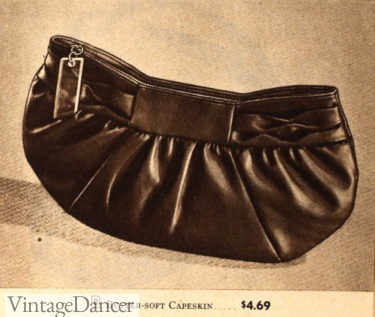
1945 a dressy day or evening bag
While surface decoration may have been scant in daytime bags, evening styles retained a decorative appeal. Beads were difficult to come by, however sequins were a perfectly adequate substitute. Evening bags would feature decorative pleating, sequins, and embroidery.
- 1948 patent leather drawstring bag
- 1946 felt drawstring flower pot bag
There was a brief fad in the early 1940s for wearing Victorian to 1920s era beaded bags, metal mesh bags and silk pouches. They were carried around the wrist or hung from a belt. Both genuine Victorian bags were reused as well as newer reproduction bags. New drawstring pouch bags were made of rayon, taffeta , faille and velvet.
- Drawstring pouch with these Victorian inspired ballgowns
- 1940 gold metal mesh chain bag
1940s evening bags were smaller than their daytime counterparts. They were usually round or square in shape, influenced by make-up bags and vanity cases. The clutch bag was a dress up favorite as well as short handle purses.
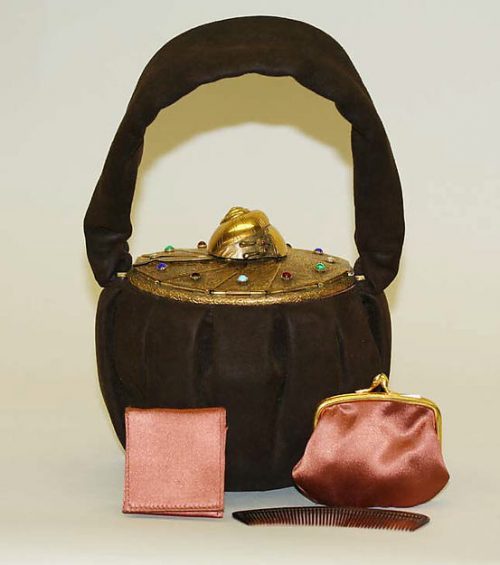
Delightful purse from the Metropolitan Museum. Here we can see the vanity case influence in evening bags of the period.
WWII Bags For Gas Masks
In 1938, gas masks were distributed in Britain, anticipating the onset of WWII. However, many citizens were somewhat lax in ensuring they carried their gas mask. By late 1939 after war had been declared, stores were producing specialist gas mask handbags – which encouraged the public to always keep their gas mask with them.
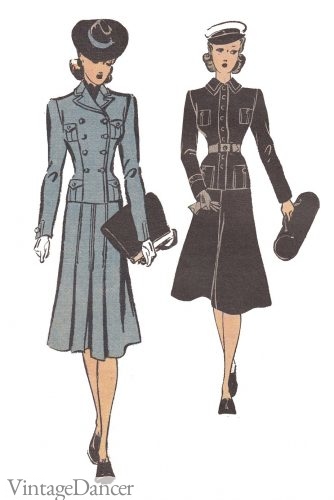
This illustration from 1940 shows the military influence across fashion and accessories.
In wartime Britain, it was strongly advised for gas masks to be carried at all times. Rather than using the standard box made of cardboard to contain and carry the gas mask, women began utilizing stylish large handbags in which to hold their gas mask. As mentioned previously, department stores realized the appeal of the handbag one may use to carry their gas mask, and so produced designs of oil cloth and leather substitutes.
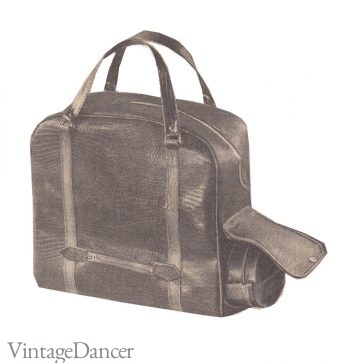
This gas mask handbag appeared in Nouveaute magazine, 1940. The article explained how to make this particular bag.
We can see from this illustration (above) which appeared in a 1940 edition of Nouveaute magazine an example of a bag made to accommodate a gas mask.
The caption that accompanied the picture read: ‘This bag will allow us to carry away easily and never to forget our gas mask, of which we must – regularly and prudently – always be equipped.”
For more information on gas mask handbags, see this article by the Imperial War Museum.
1940s Casual Bags
One of the key factors of bags of the 1940s, was the inclusion of shoulder straps. While bags from the 1910s onwards may have included short handles, bags were not generally carried on the shoulders until the 1940s.
The shoulder strap bag was all function with minimal decoration. Made of strong leather the base of the bag was often round or saddle shaped with a flap over envelope top and a long shoulder adjustable shoulder strap. They were usually flat bags or box shapes with the occasional fun round “Tambourine” bag or vanity box purse.
Teenagers and children were the largest population of users of the shoulder strap bag.
- 1944 basic flat shoulder strap bag
- 1947 pouch shape shoulder bag
- 1944 simple shoulder bag
- 1947 button detail shoulder bag
Backpacks and rucksacks were also worn, and were particularly useful if riding a bicycle, hiking or camping. The school bag or briefcase was also used not only by children and teens but by women and men needing a heavy duty travel bag. Consider too the metal lunchbox- both charming and practical.
- 1946 school bags
- 1944 briefcase school bags
1940s day bag styles included the popular satchel or messenger bag. This bag was rather masculine in appearance, yet with its multiple compartments allowed ample room for containing various items. The long straps hung over the shoulder or across the body. They went out of fashion after the war except in country settings where they remained useful for a full day’s errands.
The messenger bag and suitcase bag has returned to mainstream fashion, making the choices plentiful for vintage 1940s inspired looks.
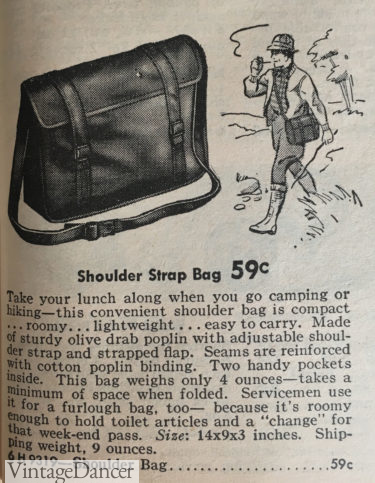
Wallets and Coin Purses
Most women’s handbags were sold with a matching small mirror and a coin purse. Women who needed a bit more than that would purchase a separate billfold wallet. These half fold wallets had space for cash, photos, and a coin pouch. Instead of coin pouches some had 4 slot columns for coins to slide in and out.
Most wallets were leather but coin purse could be a sturdy fabric in plain or plaid patterns.
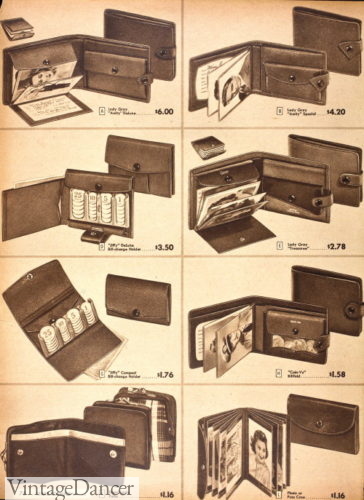
1945 women’s’ wallets and coin purses
Thrifty 1940s Purses
Besides trendy purse shops, thrift or charity shops are an ideal place to find 1940s style purses. Many cheap plastic or faux leather bags from the ’80s and ’90s look similar to the ’40s style. The three in the picture below are purses I picked up at a local thrift store.
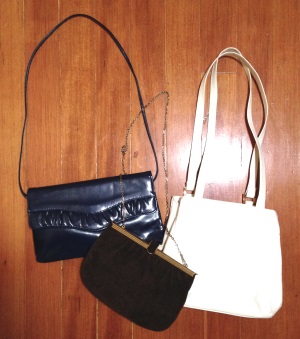
Thrifted 1940s style purses
Most modern evening purses work well for ’40s looks, too. Look for satin ruched purses, metal mesh little bags, and black flat envelope purses. For the drawstring pouch style look here under Victorian bags.
In summer, large straw bags or canvas totes look vintage enough for a trip to the seaside.
Shop 1940s Style Handbags
Most reproduction vintage bags are based on the 1950s style. Some of them can work well for the 1940s too. Try these shops:
- Unique Vintage– Day and evening handbags, clutches, purses
- Modcloth- Quirky handbags
- Ecosusi – Cute handbags, boxes, briefcase and tote bags
- Top Vintage (UK) – Mixed bands, mixed styles by decade. Quick USA shipping.
- Collectiff (UK)- Fun, 40s-50s style handbags
- Rock N Romance (UK) – Classic frame bags, faux reptile skins
- Etsy – Handmade Retro Top Shop – Leather bags large enough for modern women
- Amazon – Can be a goldmine for vintage style purses, faux leather casual bags, straw purses and tote styles.
These are 1940s inspired handbags I found online:
